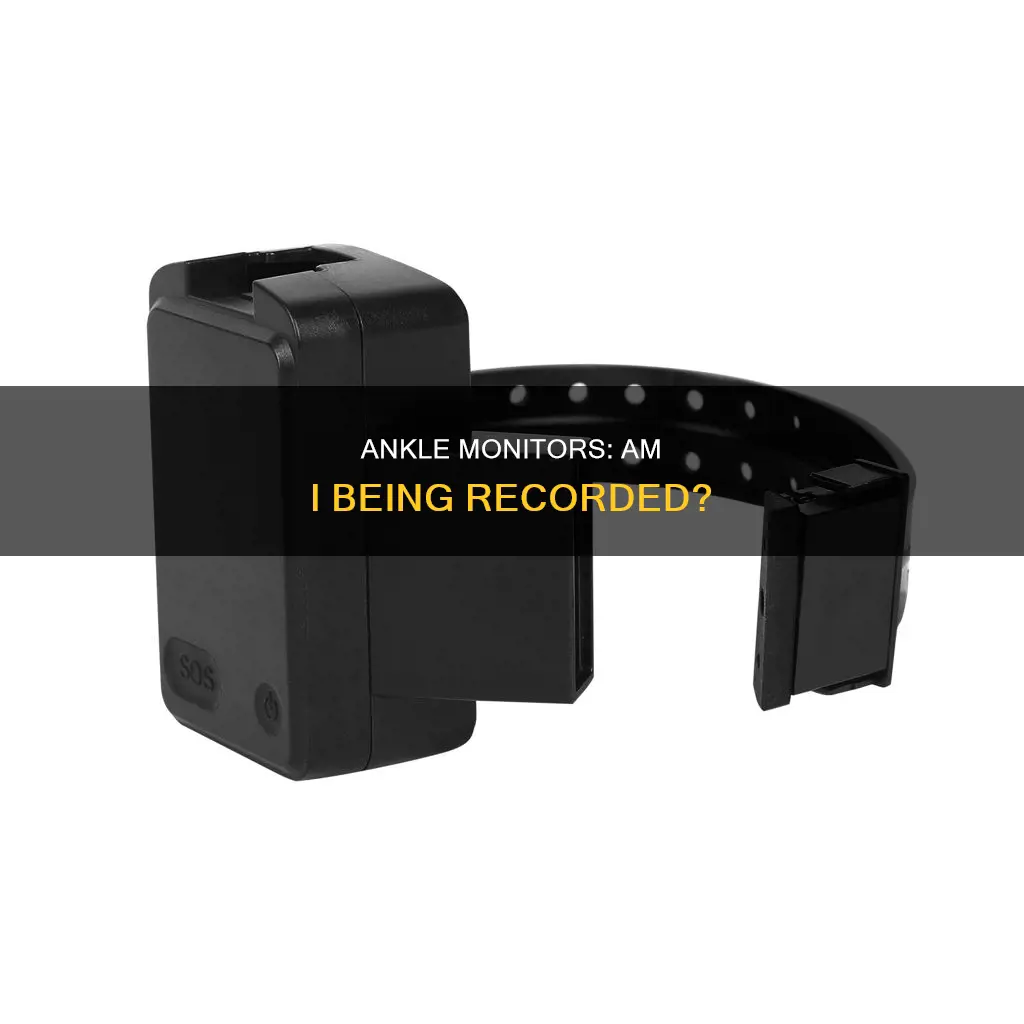
Ankle monitors are often used as an alternative to prison sentences for first-time and non-violent offenders. They are also used for people on bail or probation, and even for high school students with truancy issues. Ankle monitors are typically used to track the location of the wearer through GPS or radio frequency technology. However, there have been concerns about the privacy implications of ankle monitors, as some are equipped with microphones and recording capabilities. While ankle monitors are intended to reduce costs and prison overcrowding, critics argue that they contribute to mass incarceration and create barriers for reintegration into society.
| Characteristics | Values |
|---|---|
| Purpose | Surveillance, tracking, monitoring |
| Users | First-time and non-violent offenders, people on parole, bail, or probation, people facing immigration proceedings |
| Technology | GPS, radio frequency |
| Features | Waterproof, microphone, recorder |
| Cost | Setup fee: $100-$200; Daily fee: $3-$35; Monthly service fee: varies |
What You'll Learn

Ankle monitors can record audio without the wearer's knowledge
Ankle monitors are regularly ordered by judges as an alternative to prison or jail time. They are most commonly used during probation or for pre-trial conditions that allow the defendant to be released with local movement restrictions or under house arrest.
Ankle monitors are a form of electronic surveillance, commonly worn by defendants who have been sentenced to house arrest or those who are on parole or probation. The monitor works by transmitting the location of the wearer via GPS, allowing law enforcement to track their movements and ensure compliance with court orders.
While not all ankle monitors have a built-in microphone, some newer models do include this feature. The primary reason for including a microphone is to allow probation officers and law enforcement officials to identify the wearer from a remote location. The microphone and speaker are activated remotely, and the ankle bracelet is designed to emit a sound and vibrate before recording begins, providing a warning to the wearer.
However, there have been concerns raised about the potential for these devices to be activated without warning, recording private or incriminating conversations without the wearer's knowledge. While there are no reported cases of this happening, the possibility has sparked criticism and raised questions about potential violations of the defendant's rights.
In addition to location tracking, ankle monitors have other features such as alcohol monitoring for repeat offenders of drinking-related crimes. They can measure blood alcohol content through the wearer's skin or provide remote breathalyzer testing. This adds another layer of surveillance and monitoring to the ankle monitor's capabilities.
Finding Monitor Information in the Windows Registry
You may want to see also

They are used for tracking location via GPS or radio frequency
Ankle monitors are used for tracking location via GPS or radio frequency. They are often used as an alternative to incarceration for first-time and non-violent offenders, as well as those awaiting trial, serving probation and parole, or facing immigration proceedings. By using GPS tracking systems, authorities can record the location of the wearer and limit how long they can stay outside and where they can go. This form of electronic surveillance, also known as e-carceration, has seen a significant increase in usage, with a 140% rise in the number of active electronic monitors between 2005 and 2015.
Ankle monitors are typically used for house arrest, but they have other applications as well. For example, in Texas, high schools use ankle monitors on truant students. Additionally, they can be employed for alcohol monitoring, where devices can test sweat and detect alcohol levels in the body.
The monitors are designed to be waterproof, allowing wearers to shower or swim without issue. However, it is important to note that the signal may weaken or be blocked underwater, which could trigger an alert.
The cost of ankle monitors is typically covered by the wearer, with daily use fees ranging from $5 to $15, in addition to setup fees that can reach $200. While this is a significant expense, it is far more cost-effective than incarceration, which can cost over $20,000 per year compared to $6,000 for house arrest with an ankle monitor.
While ankle monitors provide a cheaper alternative to incarceration, they have faced criticism for their impact on wearers' lives. The restrictions on movement and the stigma associated with the devices can lead to social isolation, anxiety, and depression. Additionally, the high fees can be burdensome for households, especially those already struggling with the financial impact of incarceration.
Monitoring GPU Performance: FPS, Temps, and Usage During Gameplay
You may want to see also

Ankle monitors are used for bail, probation, parole, and immigration proceedings
Ankle monitors are often used as an alternative to incarceration, allowing individuals to remain in their homes while awaiting trial or as a condition of their probation or parole. They are also used in immigration cases and for bail.
When used for bail, ankle monitors are typically mandated by a court to ensure that the individual does not flee or engage in further criminal activity before their trial. The monitor helps ensure the individual stays within a designated area and can also track their movements and location. This information is transmitted to a base unit, usually located in the person's home, and if they go outside the designated area, the device vibrates and emits a loud tone. If they do not return to the designated area, an alert is sent to the authorities.
For probation or parole, ankle monitors are used to ensure that individuals adhere to specific rules and regulations set by the court. This may include refraining from drinking alcohol or staying within a certain radius of their home. In some cases, the monitor can also test the individual's sweat to detect alcohol consumption and relay this information to the relevant authorities.
Ankle monitors are also used in immigration cases, where individuals awaiting court dates may be required to wear them to ensure they do not flee or violate the terms of their release.
While ankle monitors can provide a way for individuals to avoid incarceration, it's important to note that they can also lead to financial burdens and medical complications. Additionally, the constant surveillance and restrictions on movement can feel like a form of imprisonment.
Understanding ELMB Sync on ASUS Monitors
You may want to see also

They are cheaper than prison
Ankle monitors are less expensive than keeping someone in jail or prison. They allow individuals to maintain their jobs and support their families, which can aid in their reintegration into society once their sentence is complete.
However, ankle monitors are not without their drawbacks. They can be uncomfortable and cause skin irritation. Additionally, individuals with ankle monitors are often subject to strict rules and regulations, and any violation of these rules can result in additional penalties or even imprisonment.
While ankle monitors are a cheaper alternative to incarceration, they also come with a host of fees. Setup fees for ankle monitors can range from $100 to $200, with daily fees ranging from $3 to $40. These fees can be exorbitant for indigent parolees, and some people may be forced to wear ankle monitors for years or even a lifetime. This can put parolees at risk of debt and unemployment, as employers are often hesitant to hire people with ankle monitors.
In some cases, the cost of ankle monitors may outweigh the benefits. For example, in South Carolina, most parolees wearing ankle monitors cannot pay the fees, resulting in the state collecting less than 1% of the total fees. This means that taxpayers are left with a tab of $3.5 million in uncollected fees. Similar issues have been seen in Wisconsin, where less than half of ankle monitor fees were collected in 2015.
Ankle monitors can also create a cycle of poverty. People often lose their jobs after incarceration, and the daily fees of an ankle monitor can put them further into debt. This financial burden can make it difficult for parolees to find employment and support their families.
While ankle monitors are indeed cheaper than prison, the costs associated with them can still be significant and may create additional challenges for those trying to reintegrate into society.
Easy Holter Monitor Electrode Removal: A Step-by-Step Guide
You may want to see also

Wearers often have to pay for the monitor and a daily use fee
Ankle monitors are often used as an alternative to prison for first-time and non-violent offenders. They are usually employed for house arrest, alcohol monitoring, or for those on bail pending a trial. The wearer typically has to pay for the cost of the monitor, as well as a daily use fee. The fees for ankle monitors can be a significant financial burden, with prices varying across different jurisdictions.
The cost of an ankle monitor typically includes a setup fee and a daily charge. Setup fees can range from $100 to $200, while the daily fee is usually between $5 and $15. Some court systems employ a sliding scale based on income and ability to pay, while others have a set fee. Over time, these fees can amount to hundreds of dollars per month, which can be challenging for individuals and families, especially those who are already dealing with the financial impact of incarceration.
In the case of Matthew Brown from Arizona, he has been on an ankle monitor for three years pending trial and is concerned about the eventual cost. He mentions that each monitor unit costs $1,740, and with a daily charge, the fees could add up to a significant amount. This prolonged use of the ankle monitor and the associated costs could potentially influence his plea, as he may feel pressured to plead guilty to avoid further expenses.
The financial implications of ankle monitors are a critical aspect of the debate surrounding their use. While they are intended to be a more cost-effective alternative to incarceration, the fees associated with their use can be a significant burden for those who are already facing economic challenges. It is important for individuals to be aware of the potential costs involved when considering the use of ankle monitors as an alternative to prison.
Water Usage Monitoring: A Standard Practice in Hotels?
You may want to see also
Frequently asked questions
You may not be able to know for sure if your ankle monitor is recording. Newer models tend to have microphones, and the microphone and speaker are activated remotely. Before turning on, the ankle bracelet emits a sound and vibrates, providing a warning to the wearer. Shortly after that, they and anyone they're with are being recorded.
No, not all ankle monitors have built-in microphones. Some do, and some don't. The feature varies from monitor to monitor and from company to company.
No, you should not attempt to prevent or tamper with your ankle monitor. If you do, the service provider will be notified, which means your probation officer will be notified, and you may face stricter punishments like a longer probation period.
Removing your ankle monitor will result in the regional monitoring center being alerted immediately. You may be punished with harsher sentencing or a longer probation period.
Yes, ankle monitors are waterproof. However, be careful when swimming or lounging in a whirlpool bathtub as the signal may be weaker or blocked completely, which could get you in trouble with your probation officer.







